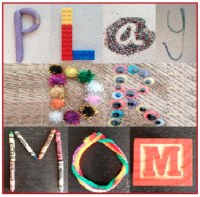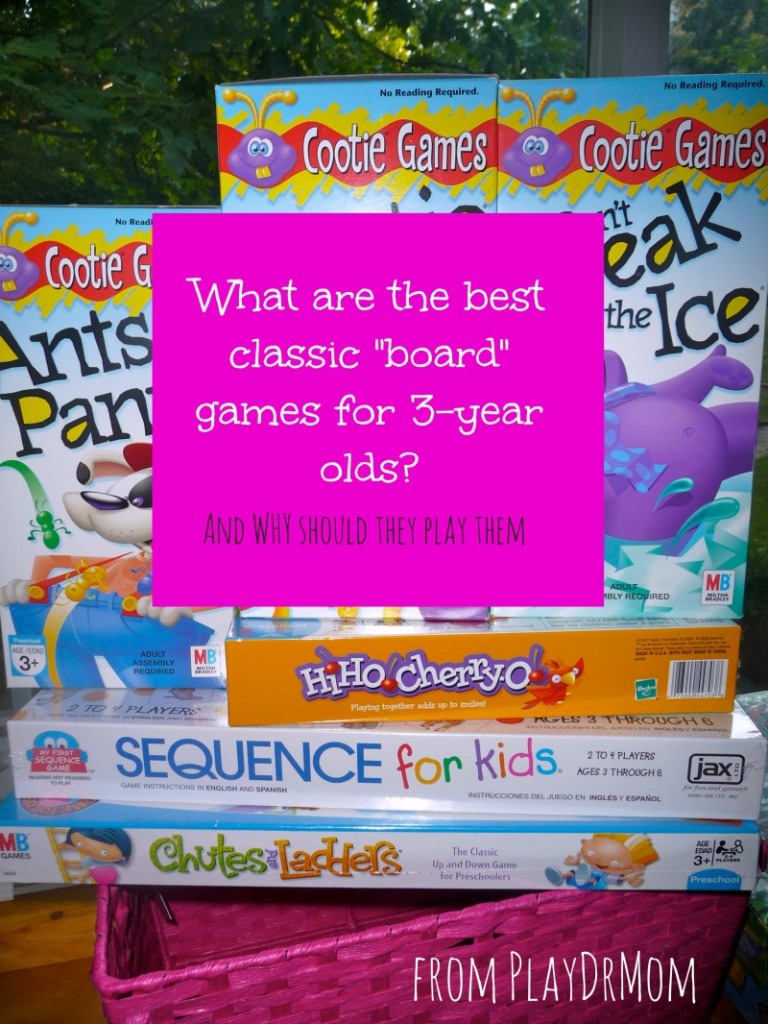Classic “Board” Games to Play with Three-Year Olds … and WHY
Three is the PERFECT age to start game play. (note: by age, I mean developmental age … which is sometimes not the chronological age of the child due to delays of all sorts). At 3, language is usually pretty well developed; also, children are increasing their attention span and ability to follow directions. Simple board games are a GREAT, playful way to increase these skills, as well as learn social skills (taking turns, following the rules, coping with frustration, handling winning … and losing). Additionally, they learn problem solving and math skills. None of the games require the child to read, allowing for more equal power and control of playing the game. Game play is a wonderful way for children and parents/adults to play TOGETHER. I frequently use board games in my work as a child psychologist for these same reasons.
Here’s the annotated list of my favorite Classic “Board” Games to Play with Three-Year Olds … and WHY:
- Chutes & Ladders (Hasbro) “Sometimes you go up, sometimes you go down.” It’s a great metaphor for life; a good reminder to us all that sometimes you lose and sometimes you win … even if you thought you were going to win (when you lose) or thought you would lose (when you win). I like this game to help kids learn resiliency, coping skills, & patience. There’s also the math skills and the social messages inherent in the game (do good things for others, you move forward; make bad choices, slide back).
- Candyland (Hasbro) Candyland is a good game to introduce game play with; there is no need for number recognition or counting skills, but it’s wonderful for teaching color identification. I will warn you though … especially if you haven’t played the game in awhile … the game can be painfully long and frustrating. Because of this I suggest you “stack” the deck (meaning put the “special” cards that take you to the different locations on the board in strategic order so that a player that’s about to win/finish back to the beginning). If you don’t want to “stack” you can also make up a new rule that once a player reaches the midpoint of the path, they can’t go back past the midpoint again.
- Ants in the Pants (Hasbro) This one is a great game for toddler or early preschoolers to start with. There’s no counting, only trying to get the different colored “ants” in the “pants” by flicking them with your finger. It’s fun because sometimes kids can be MUCH more skilled at this than the adult! You can also create many variations … competitive play is the original rules where each player gets the same amount of one color of ants and whoever gets they most in wins. But you can also play cooperatively to see how many all can get in the pants in a certain time frame (let’s say 3 minutes). However, my favorite way to play is the “feelings” way. It’s non-competitive and all try to get as many as they can in. But each time they get an ant in, they have to share a time they felt a certain feeling. The four colors of the ants each represent a different feeling (I usually play, red=angry, blue=sad, yellow=happy, and green=what ever feeling I think the child is currently struggling with). For example, “I felt mad when I asked you to get in the car and you ran the other direction.” It’s a great way for kids and parents/adults to share feelings with each other … when you’re not in the heat of the moment! (just remember it’s about feeling awareness and having FUN together, not making your child feel bad for something they did or did not do!!!)
- Cootie (Hasbro) This one is good for the “builder”! Players roll the die to create a “cootie” bug creature piece by piece. The player who finishes first wins. Kids can be creative on how they want to build their “cootie” and learn basic game skills and well as work on fine-motor skills!
- Hi Ho!Cherry-O (Hasbro) This one works on all the basic concepts of game play, plus kid’s can be exposed to simple math skills, such as counting, adding, and subtracting. Also, it has 2 versions of play … competitive and cooperative. Cooperative play games are great for kids who get very frustrated with losing (just make sure you play the other way sometimes, too!)
- Don’t Break the Ice (Hasbro) is an EXCELLENT one for kids who need to work on self-control and limits. In this game, players take turns using a mallet to pound out a “piece of ice” until the middle piece that holds a smiling red bear like creature falls. Children have to pay attention to WHERE and how hard they are hitting. They also have to STOP and let other’s take a turn … otherwise they break the ice, and lose the game. It’s also great for kids that get really anxious, because sooner or later you get stuck having to be the one that makes the bear-dude fall … and you lose … and it’s ok!
- Sequence for Kids (Jax) I bought this one recently for my 5 year old and it is much too simple for him (he’s ready for the regular version), but I think it would be great for a 3 year old child who has mastered the art of simple game play. This one takes a bit more concentration and strategic planning … also wonderful skills for them to work on. It’s a great precursor to other strategic games, like Connect Four.
- UNO MOO! (Mattel) This is the preschool version of the classic game of UNO. Instead of cards (which are very difficult for little hands to hold), players use small farm animal figures which they pull from (and put back into) small red barn. It’s a great game for color and animal learnings and matching. As well as the basic social skills learned in simple games that I mentioned earlier.
- Memory (Hasbro) There are several versions of this game out … with different themes, characters, and made my many different companies. In fact, this is an easy one to make yourself with simple hand-drawn pictures on index cards (there are many variations that I plan to blog about in the future!). This game is a great way to have kids, well … anyone, increase their memory and picture recognition skills. Just remember, for beginners … start off with only 3 or 4 pairs of cards and increase as the skill level increases.
Parents often ask, “What if they don’t want to play by the rules?” No worries! That is COMPLETELY normal and age appropriate. What I do is tell the child, “First let’s play by the rules of the game and then we can play by [child’s name] rules.” This allows children to benefit from game play, but also to be creative. Of course, most of the games they invent become extremely slanted in their favor to win! The most important thing to remember is to have fun … so, if you both stop having fun, stop the activity and do something else that is!!!
Laura Hutchison
Latest posts by Laura Hutchison (see all)
- Hacked By GeNErAL - August 21, 2015
- ABCs of Easy Crafts for Kids - August 14, 2015
- What is Learned through PLAY - August 12, 2015
- ABCs of Playground Parkbench - August 7, 2015
- ABCs of Encourage Play - July 31, 2015

















